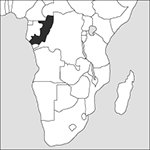
Capital:
Brazzaville
Area:
342,000 sq km (132,047 sq miles)
Population:
2,492,689 (2012 est)
Currency:
1 CFA franc = 100 centimes
Religions:
Christian 50.0%; traditional religions 48.0%
Ethnic Groups:
Kongo 48.0%; Sanga 20.0%; Teke 17.0%; Mboshi 12.0%
Languages:
French (official); Lingala; Monokutuba; Kongo; local languages
International Organizations:
UN; AU; Non-Aligned Movement; Franc Zone; WTO; OPEC
A country in western Africa, whose eastern boundary is the Congo River; it is bounded by Cameroon and the Central African Republic on the north and Gabon on the west.
Physical
On its short stretch of Atlantic Ocean coast there are lagoons, large deposits of potash and oil. A small plain rises inland to a forest-covered escarpment, while most of the country comprises savannah-covered plateaux.
Economy
Crude oil is the principal export, and oil revenues have funded a growing manufacturing base, which includes cement, food processing, and forestry. Lead, copper, zinc, and gold ore are mined. Cassava, sugar cane, and rice are the chief agricultural crops, and timber is an important export.
History
The Congo area is thought to have been uninhabited before the 15th century when Pygmies moved into the area from the north and Kongo (or Vili) people from the east. The two main kingdoms that flourished in pre-colonial times were the kingdoms of Loango and Teke, both of which prospered by supporting the slave trade. De Brazza began exploring the region in 1875 and he made the first of the series of treaties that brought it under French control in 1880. In 1888 it was united with Gabon, but was later separated from it as the Moyen Congo (Middle Congo). It was absorbed with Chad into French Equatorial Africa (1910–58). It became a member of the French Community as a constituent republic in 1958, and fully independent in 1960. In the 1960s and 1970s it suffered much from unstable governments, which alternated between civilian and military rule. Some measure of stability was achieved by the regime of Colonel Denis Sassou-Nguesso, who came to power in 1979 and was re-elected in 1989. Although a one-party Marxist state from 1970, Congo maintained links with Western nations, particularly France, from whom it gained economic assistance. In September 1990 it was agreed to adopt a multiparty political system. A new constitution was devised and accepted in a referendum in 1992. Elections held later that year produced no clear winner and a coalition was formed. The coalition collapsed and fresh elections were held in 1993. However, the results were disputed and fraud was alleged. A campaign of protest about the electoral process and results was launched by one political faction but it rapidly degenerated into fierce fighting between rival militias. Several ceasefire agreements were made and broken between 1994 and 1997, when rebel forces succeeded in re-establishing Sassou-Nguesso as President. He won elections in 2002, but fighting continued; peace was finally secured in 2003. Sassou-Nguesso was re-elected as President in 2009 in an election boycotted by most opposition candidates. Having won a refendum to remove time limits on presidential terms in 2015, he was re-elected in 2016. Congo's significant offshore oil reserves has allowed Sassou-Nguesso to prop up his power and wealth, even if he has not reduced poverty or ethnic tensions.
- cutting agent
- cutting bar
- cutting boom
- cut vector
- cut vertex
- Cuvier, Baron Georges Léopold Chrétien Frédéric Dagobert
- Cuvier, Chrétien Frédéric Dagobert (‘Georges’), Baron (1769–1832)
- Cuzick trend test
- C-V curves
- CVD
- CVG
- CVS
- CVSD
- CW
- CWIS
- cwm
- CXO
- cyanamide
- cyanamide process
- cyanate
- cyanelle
- cyanic acid
- cyanide
- cyanide process
- cyanine dyes